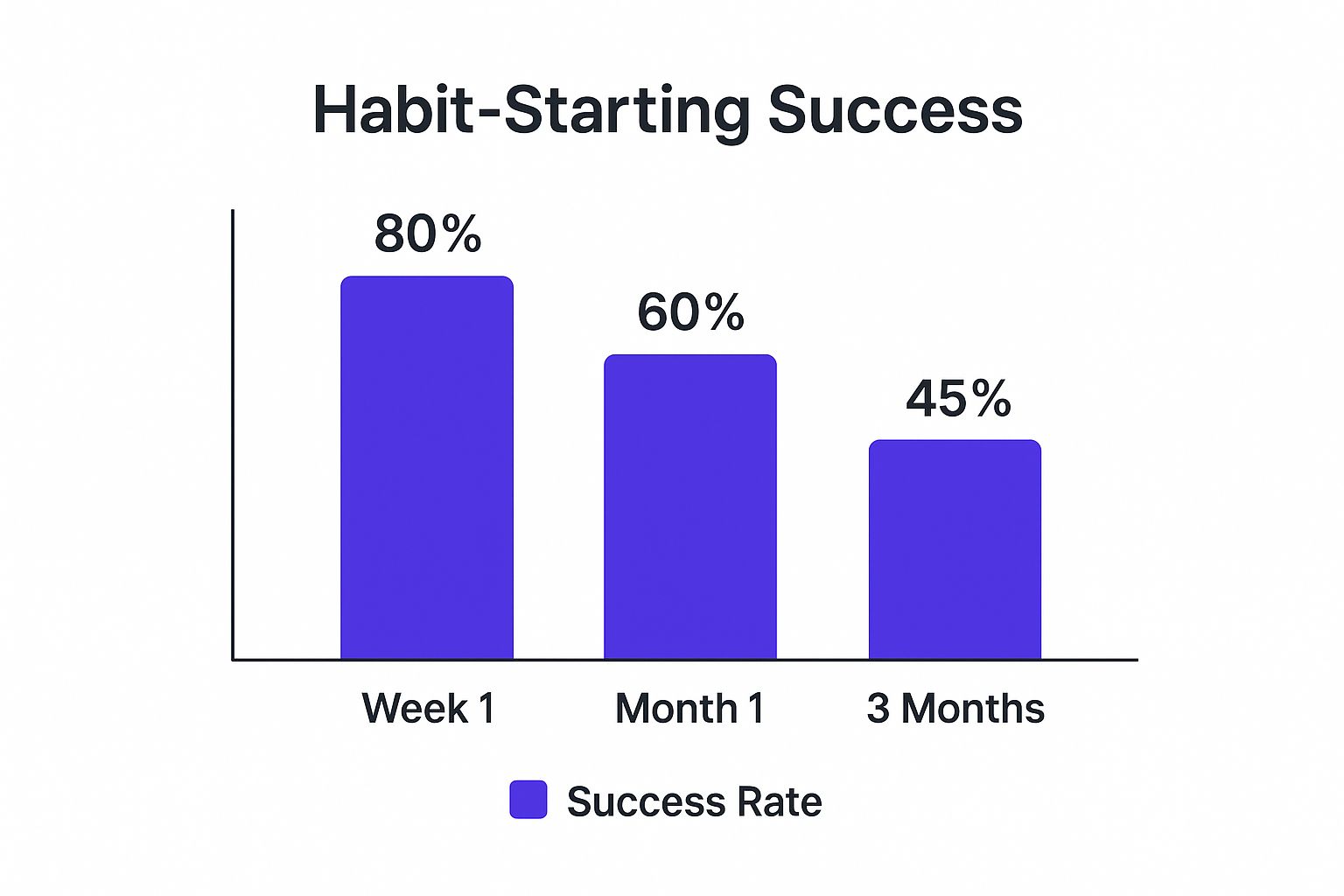The Power Behind the Start Stop Continue Exercise
The Start Stop Continue exercise is a surprisingly effective, yet simple framework. Teams looking to constantly improve their processes are using it more and more. This exercise offers a structured way to give and receive honest feedback. It helps transform vague feelings into concrete, actionable steps.
This is done by sorting behaviors and practices into three specific categories: actions to start doing, things that aren't working that should stop, and successful strategies to continue. Instead of just identifying problems, this framework helps teams work together to create solutions.
Understanding the Core Principles
This process encourages open and honest conversation. This allows teams to assess where they currently stand and plan for improvement. It's similar to taking inventory of your tools. You keep the tools that are working well, get rid of broken tools, and get new tools to fill in the gaps.
The Start Stop Continue method helps teams see their strengths, weaknesses, and areas they can develop. It also creates an environment of open communication and shared responsibility. This is because everyone participates in the evaluation and improvement process.
Origins and Evolution
The Start Stop Continue exercise is rooted in Agile Agile Software Development and Lean methodologies. These methodologies emphasize iterative processes and continuous improvement. Initially, it was a simple tool for reflection. Now, many industries have adopted it because it's adaptable and works well.
For example, in Agile environments, exercises like Start Stop Continue are critical for continuous improvement. Teams regularly review their processes every two-week sprint. This widespread use shows how valuable this exercise is, no matter the industry or team structure. Learn even more with this helpful resource: Learn more about the Start Stop Continue exercise.
Expanding the Scope
The Start Stop Continue exercise is a simple but powerful tool for continuous improvement. Much like a gardener prunes a plant to encourage healthy growth, this exercise helps teams get rid of unproductive practices and cultivate effective ones. This regular reflection and adjustment creates more agile, adaptable, and ultimately, successful teams. For more information on how Start, Stop, Continue can improve infosec programs, check out this blog article: Start, Stop, and Continue: Applying the Concept to Infosec Programs.

Measurable Benefits You Can Achieve
The Start Stop Continue exercise isn't just a feel-good team activity; it generates real, positive changes. This structured approach builds psychological safety, enabling team members to share feedback they might otherwise hold back. This open communication is vital for a team to reach its full potential.
Boosting Team Dynamics
This method significantly improves team alignment. When everyone understands what the team should start, stop, and continue doing, they work together more effectively. This shared understanding simplifies workflows and creates unity, driving the team toward common goals. This can also lead to innovative breakthroughs often missed with traditional feedback methods.
For instance, a team might "start" scheduling brainstorming sessions, "stop" relying solely on email, and "continue" their weekly progress meetings. These targeted changes, based on collective feedback, can greatly improve team performance and innovation. Check out these Creative Thinking Exercises for Teams.
Tangible Results in Your Workplace
Organizations using Start Stop Continue sessions see noticeable gains in productivity, conflict resolution, and employee retention. A key advantage of this exercise is its ability to promote constructive feedback and encourage positive behavioral changes. It’s a particularly good alternative to traditional performance reviews, which can be inefficient and time-consuming.
Instead of annual reviews, companies can use the Start Stop Continue model for frequent, actionable feedback. This helps teams react faster to market shifts, increasing adaptability and fostering innovation. Learn more with this Start Stop Continue Retrospective Guide. These benefits highlight the long-term positive effects of this simple yet powerful technique.
Visualizing Progress and Impact
To better illustrate how Start Stop Continue fosters ongoing improvement, take a look at the infographic below. It visually represents habit formation success rates over time.

The infographic shows that initial enthusiasm can be high (e.g., 80% in the first week). However, real improvement requires consistent effort and feedback. The drop in percentages over the first month and three months highlights the importance of regular Start Stop Continue sessions. These sessions reinforce positive changes and address emerging challenges, driving lasting improvements.
Let's compare traditional reviews with the Start Stop Continue approach to highlight the key differences. The table below summarizes these distinctions.
| Aspect | Traditional Reviews | Start Stop Continue Approach |
|---|---|---|
| Frequency | Typically annual | Regular, ongoing |
| Focus | Past performance evaluation | Future improvement and action |
| Feedback | Often one-way, from manager to employee | Multi-directional, from all team members |
| Actionability | Limited, often lacking concrete next steps | High, with clear "start, stop, continue" actions |
| Impact | Can feel judgmental and demotivating | Encourages positive change and team ownership |
This table clearly shows how the Start Stop Continue method provides a more dynamic and actionable approach to feedback compared to traditional performance reviews. Its regular frequency, focus on the future, and multi-directional feedback foster a culture of continuous improvement and team collaboration.
Facilitating Sessions That Actually Drive Change

Running a successful start stop continue exercise involves more than simply asking the three basic questions. It requires thoughtful planning and adept facilitation to transform feedback into meaningful action. This means creating the right atmosphere and guiding the discussion effectively. This section offers a practical guide for achieving these goals.
Setting the Stage for Success
The environment significantly influences the quality of feedback received. A space where individuals feel safe sharing honest opinions is paramount. This fosters psychological safety, encouraging contributions from everyone, including those who might typically hold back. This could mean selecting a comfortable physical location or a well-structured virtual meeting room, free from interruptions. For tips on virtual meetings, check out this article on How to Master Remote Workshops.
Establishing clear ground rules is also vital. These guidelines promote respectful communication and ensure balanced input. For instance, time limits for each person's response can prevent certain voices from dominating the conversation. This cultivates a more inclusive environment for diverse personalities.
Facilitating Deep and Meaningful Discussions
Effective facilitation helps teams delve beyond surface-level comments. Asking thoughtful, open-ended questions helps uncover the root causes of issues and identify recurring themes. It's similar to an archaeologist meticulously excavating a site; they don't just observe the surface, they dig deeper to understand the context and history.
Instead of asking "What should we stop doing?", a facilitator could ask "Which processes are hindering our efficiency, and what are the reasons behind this?" This encourages more insightful answers and deeper analysis. Using visual aids like whiteboards or online collaboration tools like Miro can also keep the discussion organized and engaging.
Overcoming Common Challenges
Despite careful preparation, challenges can still emerge. Dominant personalities, resistance to feedback, and difficulty implementing feedback are common obstacles. However, skilled facilitators can address these issues by actively managing the discussion, promoting different perspectives, and reinforcing the importance of constructive criticism.
This might involve gently redirecting dominant individuals to create space for others to speak. Or, it might involve rephrasing negative feedback more constructively. Creating a concrete action plan from the feedback is essential. This plan should outline clear steps, assign ownership, and establish accountability. This translates insights into real changes.
Adapting for Different Team Dynamics
The start stop continue exercise can be adapted for remote teams, cross-functional groups, and teams with varying levels of psychological safety. For remote teams, utilizing collaboration tools and clear communication protocols is key. With cross-functional groups, focusing on shared processes and objectives helps bridge departmental gaps.
In environments with lower psychological safety, building trust and rapport is crucial. This could involve using icebreaker activities or incorporating anonymous feedback rounds. The objective is to create an environment where everyone feels comfortable contributing honestly. By understanding team dynamics and adapting accordingly, facilitators can maximize the effectiveness of the exercise.
Applying Start Stop Continue to Personal Transformation
The Start Stop Continue exercise is a powerful tool, often used for team development. However, it can also be a catalyst for individual growth. This framework provides a structured approach to self-improvement, applicable to various aspects of personal life, from career advancement to relationship building. The process encourages reflection on current behaviors and habits, helping you identify areas for change and growth.
Transforming Habits and Behaviors
Just as teams identify actions to start, stop, and continue, individuals can apply these same principles to their personal lives. This involves an honest self-assessment, pinpointing habits that hinder progress and those that contribute to positive outcomes.
For example, someone wanting to improve their fitness might start meal prepping healthy lunches, stop late-night snacking, and continue their morning workout routine. This structured approach helps translate intentions into concrete actions.
The framework is adaptable. What works at one stage of personal development might need adjustment later. The Start Stop Continue exercise isn't limited to professional settings. It can be used to improve dynamics and boost productivity at home or in small groups, too.
For example, a couple might use this exercise to reorganize their daily routines. They might start a new habit of scheduling quality time together, stop the habit of watching excessive TV, and continue their regular exercise routine. This exercise encourages honest conversations and helps identify areas for improvement, leading to tangible changes. Explore this topic further.
Overcoming Self-Assessment Blind Spots
One common challenge in personal development is the presence of blind spots in self-perception. We might not always accurately assess our strengths and weaknesses, making it difficult to identify areas for improvement.
The Start Stop Continue framework addresses this by encouraging external feedback. Seeking input from trusted friends, family, or mentors can provide valuable perspectives, uncovering hidden areas for growth.
This external feedback, combined with self-reflection, offers a more comprehensive understanding of your behaviors and their impact. This holistic view is crucial for effective personal transformation.
Building Accountability and Tracking Progress
Personal development requires self-driven systems of accountability. Using tools like journals, habit trackers, or accountability partners can significantly enhance commitment to your Start Stop Continue plan.
Regularly reviewing progress, celebrating achievements, and adjusting the plan as needed helps maintain momentum. It’s similar to a ship’s captain constantly adjusting course based on weather conditions and progress toward the destination. This regular monitoring and adjustment are essential for navigating personal transformation.
Applying the Framework Across Life Domains
The Start Stop Continue exercise can be adapted to various areas of personal growth. The table below provides examples of how this framework can be applied to different aspects of life.
To help illustrate the versatility of this framework, let's take a look at the following table:
| Life Area | Start Examples | Stop Examples | Continue Examples |
|---|---|---|---|
| Career | Networking actively | Procrastinating on important tasks | Seeking learning opportunities |
| Relationships | Expressing appreciation more often | Avoiding difficult conversations | Scheduling quality time |
| Health | Mindful eating | Negative self-talk | Regular exercise |
| Finances | Budgeting and saving | Impulsive spending | Investing wisely |
This table shows how easily adaptable the Start Stop Continue method can be. This flexible framework allows you to tailor the exercise to your specific needs and goals, fostering personal transformation across multiple life domains. This method offers a powerful path toward achieving a more fulfilling and balanced life.

Customizing the Framework For Maximum Impact
The Start Stop Continue exercise, while simple, isn't one-size-fits-all. Its effectiveness depends on tailoring it to your team's specific needs. This means adapting the framework for different team environments, organizational structures, and objectives.
Adapting To Different Team Environments
Different teams face unique challenges and have distinct communication styles. Executive teams might use the Start Stop Continue framework to evaluate strategic initiatives, focusing on high-level goals and market trends. For example, they might start exploring new partnerships, stop investing in a declining product line, and continue focusing on customer acquisition.
Creative teams, however, might use the exercise to improve brainstorming and collaboration. They could start using visual brainstorming tools like Miro, stop relying solely on email, and continue holding regular brainstorming sessions. Technical teams might focus on optimizing workflows and problem-solving. They might start implementing daily stand-up meetings, stop using outdated software, and continue peer code reviews. Learn more in this article about How to master creative problem solving.
Tailoring To Organizational Context
Implementation also varies based on the organization. A fast-scaling startup might use the exercise frequently, perhaps weekly, to adapt to rapid changes. They could focus on streamlining communication and identifying emerging challenges.
A well-established enterprise, in contrast, might use the exercise less often, focusing on refining existing processes and improving team alignment. The Start Stop Continue exercise can also be used for personal growth, much like the process of discovering your purpose. During organizational change, this exercise can be especially valuable for identifying areas needing adjustment and building team consensus.
Determining Optimal Frequency and Format
The right frequency and format depend on factors like team maturity, communication patterns, and objectives. A new team might benefit from more frequent sessions to build trust and establish effective communication. Teams with strong existing communication might find less frequent sessions are sufficient.
The format can also vary. Some teams prefer structured sessions with set questions, while others prefer a more open approach. Using tools like whiteboards, sticky notes (physical or virtual), and online collaboration software like Microsoft Teams can help organize feedback and track progress.
Refreshing and Evolving the Practice
Regularly evaluating the Start Stop Continue exercise itself is important. As teams evolve, the exercise should too. This might involve changing the format, frequency, or focusing on different aspects of team performance. Periodically revisiting the exercise's goals and adapting the approach helps maintain its value and ensures it continues to drive meaningful improvement.

Measuring Success Beyond Good Feelings
Transforming your Start Stop Continue exercise from a simple activity into a powerful engine for improvement involves moving beyond gut feelings and embracing data-driven insights. This means using both quantitative and qualitative measurement frameworks to track actual progress.
Establishing Meaningful Baselines
Before implementing the Start Stop Continue exercise, it's essential to establish clear baselines. These baselines act as a benchmark against which you can measure future progress. Think of it like calibrating a scientific instrument before taking measurements; it ensures accuracy and reliability. For example, if a team wants to improve communication, they might measure their current meeting effectiveness with a short survey before their first Start Stop Continue session.
Selecting the Right Metrics
Choosing metrics that align with your organizational objectives is key. If the goal is to improve project delivery speed, team velocity could be a valuable metric. If the goal is to improve employee morale, employee engagement scores become more relevant. This focused approach makes sure that the Start Stop Continue exercise contributes to achieving your overall goals.
Implementing Lightweight Tracking Systems
Tracking your progress doesn’t need to be complicated. Simple spreadsheets, project management software, or even online collaboration tools can effectively capture Start Stop Continue actions and track progress. The key is to choose a system that’s easy to use and doesn’t create extra work for the team. This minimizes resistance and encourages everyone to use it consistently.
Connecting the Exercise to Performance Indicators
Many leading organizations connect their Start Stop Continue practice directly to performance indicators. This helps quantify the impact of the exercise and demonstrate its value. For instance, a team might track how changes implemented through the Start Stop Continue process correlate with improvements in customer satisfaction or a reduction in project defects. This data-driven approach strengthens the feedback and promotes continued engagement.
Recognizing Diminishing Returns and Refreshing Your Approach
Over time, the Start Stop Continue exercise might become less effective. This can happen when teams become complacent or the same issues keep recurring. Recognizing these diminishing returns is crucial. It might be time to refresh the exercise by changing the format, introducing new questions, or focusing on different areas for improvement. This ongoing evolution ensures that the Start Stop Continue method remains a valuable tool for driving positive change.
This means periodically reviewing your team’s Start Stop Continue process and making adjustments as needed. Think of it like tending a garden; you need to adapt your care as the plants grow and change. This mindset of continuous improvement is essential for maintaining the exercise’s effectiveness and achieving long-term team success.
Ready to transform your team's brainstorming and collaboration? Bulby is a brainstorming tool designed for remote teams. With AI-powered guidance and research-backed exercises, Bulby helps teams generate innovative ideas, improve communication, and achieve tangible results. Visit Bulby today to learn more and start your free trial.

